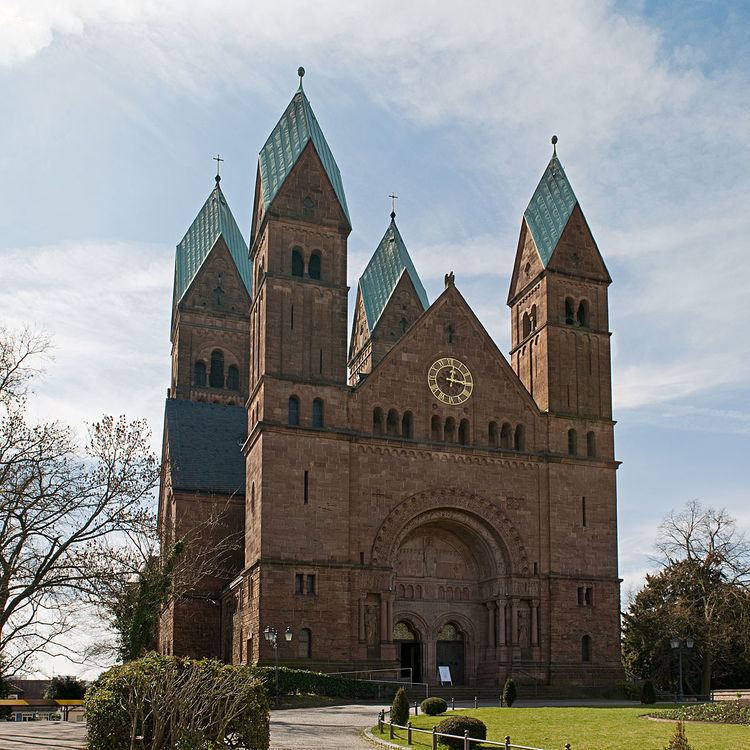Location Bad Homburg Completed 1908 Phone +49 6172 21089 | Functional status Active Opened 1908 | |
 | ||
Website www.erloeserkirche-badhomburg.de Address Dorotheenstraße 1, 61348 Bad Homburg vor der Höhe, Germany Architects Franz Heinrich Schwechten, Max Spitta Similar Maison gothique, Château de Bad Homburg, Saalburg, Sinclair‑Haus, Kaiser Wilhelm Bad | ||
The Church of the Redeemer (German: Erlöserkirche) of Bad Homburg belongs to the Protestant Church in Germany. Finished in 1908, the building is outwardly of a heavy, Romanesque Revival appearance, while its interior is held in a neo-Byzantine style, with rich marble wall decorations and gold mosaics covering the domed ceiling, leading to the church sometimes being called 'Bad Homburg's Hagia Sophia'.
Contents
History
The church was built to serve Bad Homburg's Evangelical Christians which around the start of the 20th century suffered from lack of a sufficient congregation space. Its construction was paid for and the design supervised by Wilhelm II, the German Emperor, who had by then made Bad Homburg a summer residence town, and later often came to worship in the church, sitting in his own imperial box with a private entrance. Empress Auguste-Viktoria also provided the jewel-studded altar cross which was originally intended for the Church of the Redeemer in Jerusalem.
In 1901, the Berlin architect Max Spitta was entrusted with the construction plans for the church. However, as Spitta died in December 1902, architect Franz Schwechten finished the design in late Romanesque style. The foundation was laid in 1903 and the new church was inaugurated in the presence of the imperial couple on 17 May 1908. The building was primarily constructed by the Philipp Holzmann Company from Frankfurt. The numerous artisan works inside the building were the work of local craft shops.
Architecture
The church is a cross-shaped structure basilica with four towers, with blind arcades and a high two-door portal arch for the tympanum. The towers on the altar side are larger and higher than those on the entrance side, which gives the building a noticeable shift in perspective, especially from afar.
The exterior façade was designed by Professor Gotthold Riegelmann and is reminiscent of Rhenish Imperial cathedrals. The interior design and decoration however are reminiscent of the Hagia Sophia. The interior consists of a mixture of Byzantine and Art Nouveau. The theme of Christ the Redeemer is ubiquitous throughout the church, and culminates in the Christ Pantocrator mosaic of the apse vault.
Organs
Two large church organs are installed in the Erlöserkirche. A turn-of-the-20th-century Sauer organ and a new Bach organ based on a 1742 Thuringian model.
Sauer-Organ (1908)
The Sauer organ whose sound outlet is located above the altar was built in 1908 by Wilhelm Sauer (Frankfurt / Oder).
Woehl-Organ (1990)
Gerald Woehl created in 1990 the Bach organ implementing a design of Johann Sebastian Bach. The organ is located on the gallery balustrade and forms with the Sauer organ a compositional unit.
Church Bells
The church bells consist of five different bells. The largest weighs approximately 6,400 kg. The first four bells were cast in 1905 by the Andreas Hamm bell foundry in Frankenthal. In the 1920s, the Zwingli bell ('Zwingliglocke') was transferred from the neighboring village, Kirdorf, to serve as hour bell. Bells 1, 3 and 4 survived the First and Second World War. Although the second bell, the Landgraff bell ('Landgrafenglocke'), survived the First World War, it was damaged during the Second World War. From the shards of the second bell a new bell was cast by the Schilling bell foundry.
